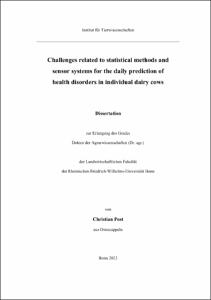Challenges related to statistical methods and sensor systems for the daily prediction of health disorders in individual dairy cows

Challenges related to statistical methods and sensor systems for the daily prediction of health disorders in individual dairy cows

| dc.contributor.advisor | Sauerwein, Helga | |
| dc.contributor.author | Post, Christian | |
| dc.date.accessioned | 2023-02-02T12:57:37Z | |
| dc.date.available | 2023-02-02T12:57:37Z | |
| dc.date.issued | 02.02.2023 | |
| dc.identifier.uri | https://hdl.handle.net/20.500.11811/10611 | |
| dc.description.abstract | The use of digital support systems has become a standard in dairy farming, and significant effort has been made to detect individual animals that are in need for a treatment by using sensor data. However, developing systems that are of actual use for practical farming remains a challenge. A variety of combinations of sensor systems and statistical algorithms for the detection of problems related to mastitis and lameness has been investigated to this date. These studies are mostly limited to certain conditions, models, and dependent variables that describe the disease to be detected, which makes them difficult to compare with one another and adapt to new datasets. An inherent challenge is the low prevalence of disease or treatment events, respectively, when looking at each individual cow on a day-by-day basis. As a result, even models with seemingly suitable combinations of sensitivity and specificity produce a large portion of false positive alarms.
Within the framework of this dissertation, two studies addressing these challenges were carried out and published. The aim of the first study was to use available (sensor) data from the Frankenforst experimental farm of the University of Bonn to develop classification models with which cows in need of treatments for lameness and mastitis could be detected. A wide range of statistical and machine learning algorithms were tested, as well as different ways of re-sampling the training data to achieve class balance between days with and without treatment. The ExtraTrees Classifier model achieved the best results with a mean area under curve (AUC) of 0.79 for mastitis and 0.71 for lameness treatments, while the sampling methods had no significant influence on the results. In a second subsequent study, the four best models from the first study were re-trained with an expanded data base to include data from two additional experimental farms in order to test the transferability of the developed models to previously unknown data from two additional farms. For this purpose, the models were trained on data from one farm and then tested on the remaining farms’ data. In addition, special attention was paid to the possibility of reducing false alarms by forming risk groups and risk times in the data and testing their potential to increase the relative frequency of occurrence of treatment days and thus a higher positive predictive value. It was found that the models showed poorer detection performances for data from an unknown farm, especially for lameness treatments, so that in conclusion training on data from the same farm was recommended. Regarding the subgroups with a higher risk for a treatment, especially the cows with a previous treatment of the same category (mastitis or lameness) in the current lactation showed a significantly increased risk compared to the test data without grouping. However, the resulting increased positive predictive values (up to 20%) are still not sufficient for satisfactory use in practice. Here it was shown that the problem of the high number of false alarms is predominantly based in stochastics, which challenges the use of such models for the daily detection of cows, or livestock in general, in need of a treatment. Overall, it is essential for the discussion to shift towards how these sensor systems can meet the requirements and expectations for practical decision support systems. Future research needs to focus on the transferability of the individual experimental conditions, the specificity of the features derived from sensor data, the choice of statistical models and especially the daily prevalence of the condition to be detected. | en |
| dc.language.iso | eng | |
| dc.rights | In Copyright | |
| dc.rights.uri | http://rightsstatements.org/vocab/InC/1.0/ | |
| dc.subject | Tierwohl | |
| dc.subject | Mastitis | |
| dc.subject | Lahmheit | |
| dc.subject | Milchkühe | |
| dc.subject | Maschinelles Lernen | |
| dc.subject | animal welfare | |
| dc.subject | mastitis | |
| dc.subject | lameness | |
| dc.subject | dairy cows | |
| dc.subject | machine learning | |
| dc.subject.ddc | 630 Landwirtschaft, Veterinärmedizin | |
| dc.title | Challenges related to statistical methods and sensor systems for the daily prediction of health disorders in individual dairy cows | |
| dc.type | Dissertation oder Habilitation | |
| dc.publisher.name | Universitäts- und Landesbibliothek Bonn | |
| dc.publisher.location | Bonn | |
| dc.rights.accessRights | openAccess | |
| dc.identifier.urn | https://nbn-resolving.org/urn:nbn:de:hbz:5-69684 | |
| dc.relation.doi | https://doi.org/10.3390/s21041389 | |
| dc.relation.doi | https://doi.org/10.3390/s20143863 | |
| ulbbn.pubtype | Erstveröffentlichung | |
| ulbbnediss.affiliation.name | Rheinische Friedrich-Wilhelms-Universität Bonn | |
| ulbbnediss.affiliation.location | Bonn | |
| ulbbnediss.thesis.level | Dissertation | |
| ulbbnediss.dissID | 6968 | |
| ulbbnediss.date.accepted | 16.12.2022 | |
| ulbbnediss.institute | Landwirtschaftliche Fakultät : Institut für Tierwissenschaften (ITW) | |
| ulbbnediss.fakultaet | Landwirtschaftliche Fakultät | |
| dc.contributor.coReferee | Büscher, Wolfgang | |
| ulbbnediss.contributor.orcid | https://orcid.org/0000-0001-5746-7830 |
Dateien zu dieser Ressource
Das Dokument erscheint in:
-
E-Dissertationen (1116)




